名词
图片预览

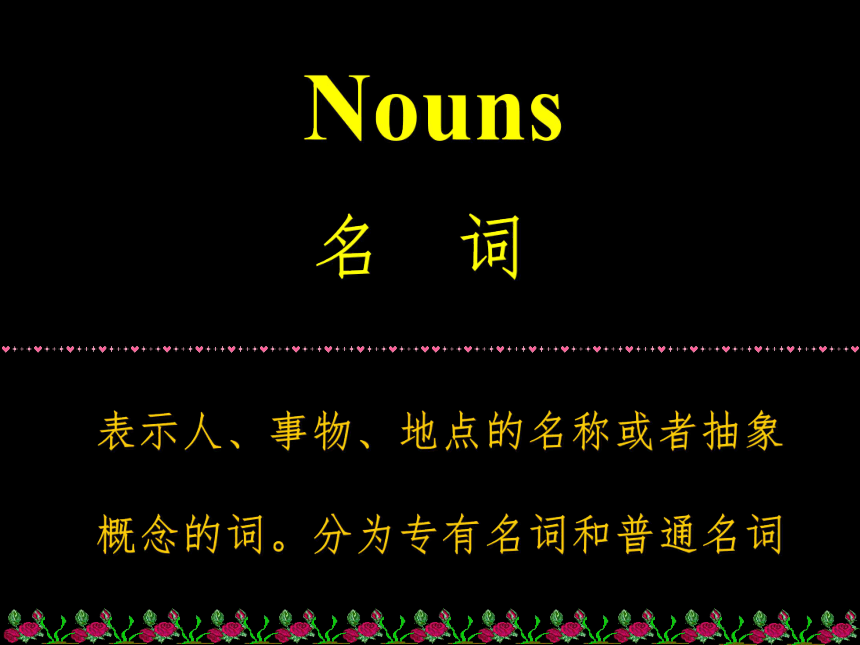
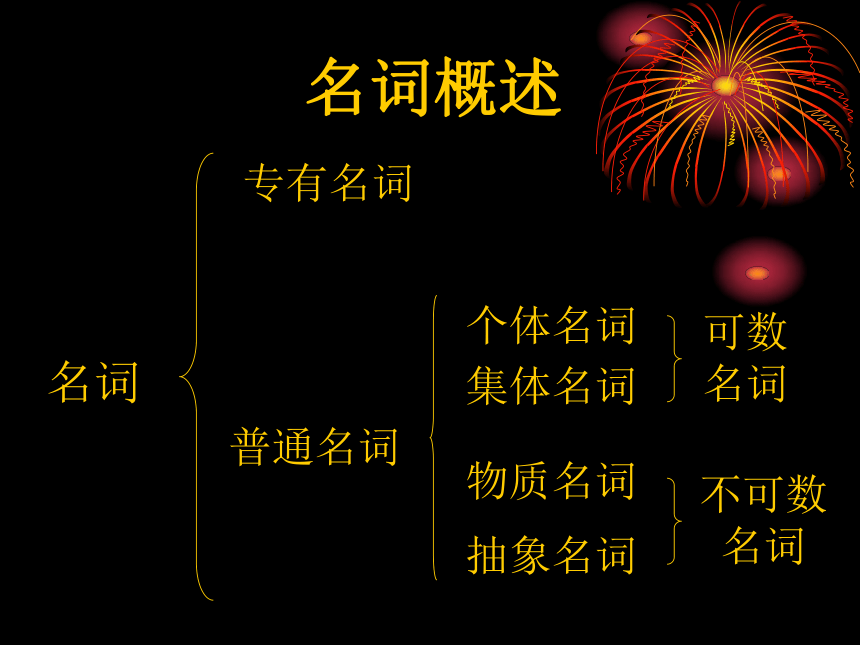
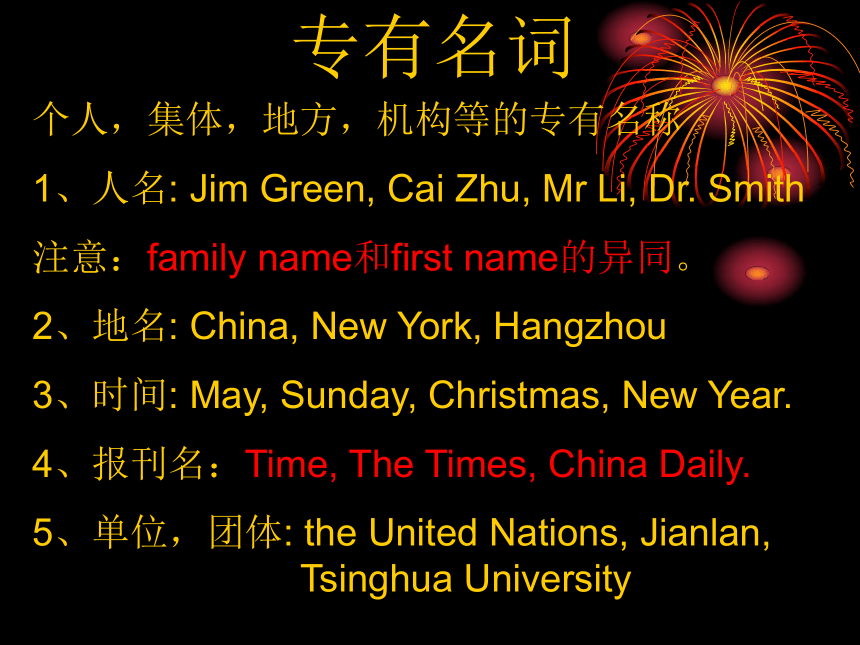
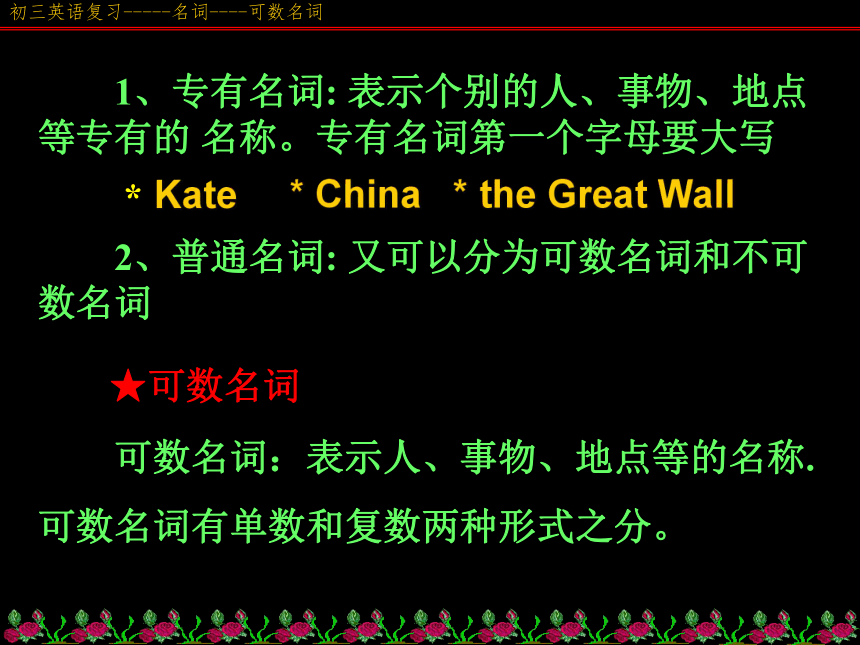
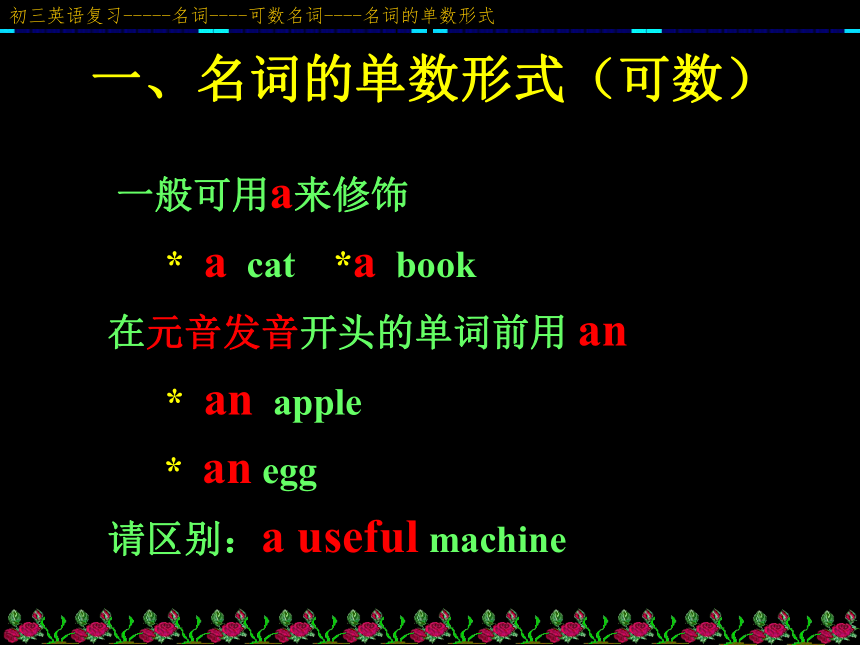
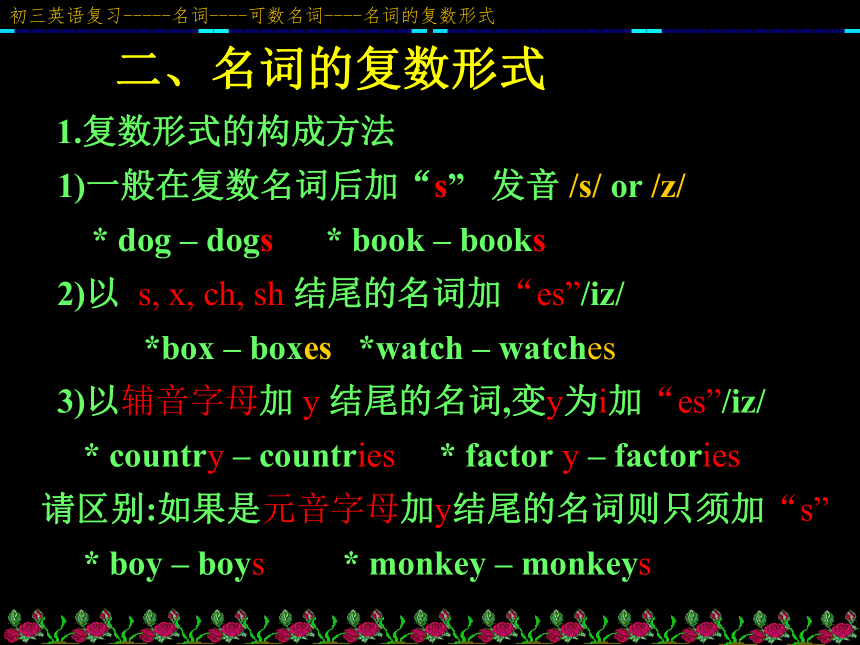
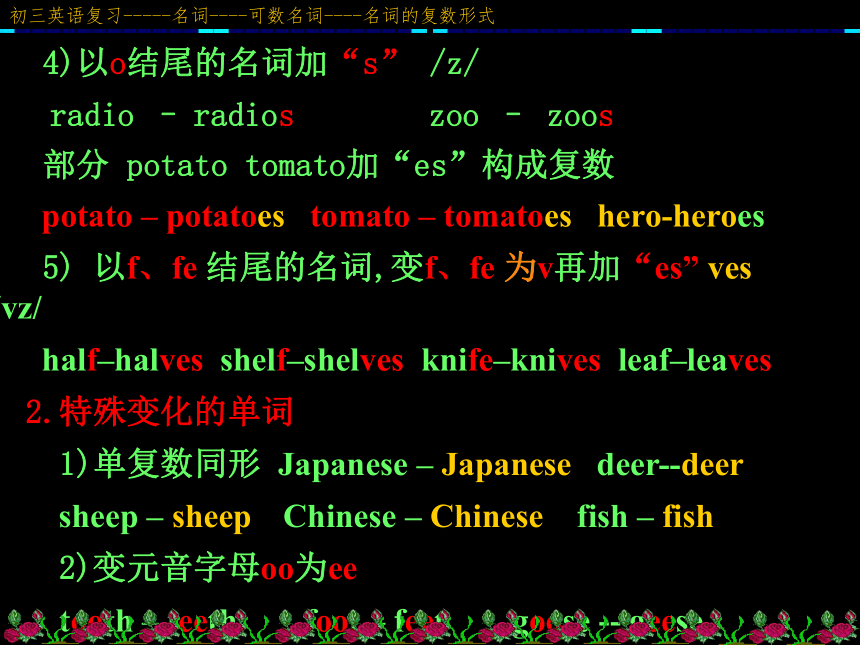
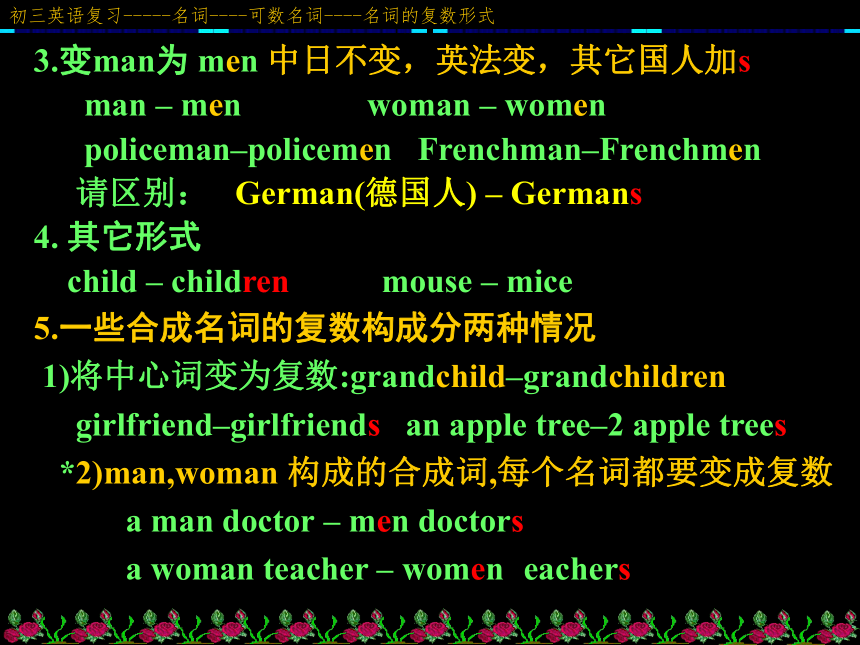
文档简介
(共28张PPT)
初三英语复习
Revision
of Junior English
Nouns
名 词
表示人、事物、地点的名称或者抽象
概念的词。分为专有名词和普通名词
名词概述
名词
专有名词
普通名词
个体名词
集体名词
物质名词
抽象名词
可数名词
不可数名词
专有名词
个人,集体,地方,机构等的专有名称
1、人名: Jim Green, Cai Zhu, Mr Li, Dr. Smith
注意:family name和first name的异同。
2、地名: China, New York, Hangzhou
3、时间: May, Sunday, Christmas, New Year.
4、报刊名:Time, The Times, China Daily.
5、单位,团体: the United Nations, Jianlan, Tsinghua University
1、专有名词: 表示个别的人、事物、地点等专有的 名称。专有名词第一个字母要大写
*
2、普通名词: 又可以分为可数名词和不可数名词
★可数名词
可数名词:表示人、事物、地点等的名称.
可数名词有单数和复数两种形式之分。
初三英语复习-----名词----可数名词
Kate * China * the Great Wall
一、名词的单数形式(可数)
一般可用a来修饰
* a cat *a book
在元音发音开头的单词前用 an
* an apple
* an egg
请区别:a useful machine
初三英语复习-----名词----可数名词----名词的单数形式
二、名词的复数形式
1.复数形式的构成方法
1)一般在复数名词后加“s” 发音 /s/ or /z/
* dog – dogs * book – books
2)以 s, x, ch, sh 结尾的名词加“es”/iz/
*box – boxes *watch – watches
3)以辅音字母加 y 结尾的名词,变y为i加“es”/iz/
* country – countries * factor y – factories
请区别:如果是元音字母加y结尾的名词则只须加“s”
* boy – boys * monkey – monkeys
初三英语复习-----名词----可数名词----名词的复数形式
4)以o结尾的名词加“s” /z/
radio – radios zoo – zoos
部分 potato tomato加“es”构成复数
potato – potatoes tomato – tomatoes hero-heroes
5) 以f、fe 结尾的名词,变f、fe 为v再加“es” ves /vz/
half–halves shelf–shelves knife–knives leaf–leaves
2.特殊变化的单词
1)单复数同形 Japanese – Japanese deer--deer
sheep – sheep Chinese – Chinese fish – fish
2)变元音字母oo为ee
tooth – teeth foot – feet goose -- geese
初三英语复习-----名词----可数名词----名词的复数形式
3.变man为 men 中日不变,英法变,其它国人加s
man – men woman – women
policeman–policemen Frenchman–Frenchmen
请区别: German(德国人) – Germans
4. 其它形式
child – children mouse – mice
5.一些合成名词的复数构成分两种情况
1)将中心词变为复数:grandchild–grandchildren
girlfriend–girlfriends an apple tree–2 apple trees
*2)man,woman 构成的合成词,每个名词都要变成复数
a man doctor – men doctors
a woman teacher – women teachers
初三英语复习-----名词----可数名词----名词的复数形式
6.常以复数形式出现的名词
people clothes police trousers glasses
这些名词作主语时,注意它们的谓语用复数
* My clothes are newer than yours.
* The police often come here.
7.how many,many,a few,few,any,lots of,
some,a lot of 修饰可数名词复数
*There are a few people in the park.
*How many knives are there in your pencil-box
初三英语复习-----名词----可数名词----名词的复数形式
★不可数名词
不可数名词: 物质名词和抽象名词,属于不可数名词。例如:
water,rice,fish,meat 等。
特别记住:
work time space music money
weather cotton homework wood
information news medicine
初三英语复习-----名词----可数名词----名词的复数形式
1.不可数名词无复数,作主语时常看成单数
*Some bread is over there. *No news is good news.
2.常用how much, much, a little, little, a lot of, some, any等用来修饰不可数名词
*They had much money.
*He does little housework at home.
3.常用a piece of, a cup of, a glass of,a bottle of 等来表示不可数名词的量,单复数表现在of 前面的名词上,而 of 后始终是单数
*There is a piece of paper in the book.
*Three glasses of orange (?) are on the desk.
初三英语复习-----名词----可数名词----名词的复数形式
注意:
可数名词也可用量来表示,of 后用复数
* There are two bags of clothes over there.
* We have five boxes of apples.
初三英语复习-----名词----可数名词----名词的复数形式
4.有些可数名词或不可数名词在一定情况下可相互转化,同一个词,不同意思
(1)glass(玻璃)_____a glass(玻璃杯)
paper(纸) _____ a paper(报纸,论文)
work(工作) ____a work(著作)
room(空间) ____ a room(房间)
(2) fruit(水果) ____ fruits (各种水果)
fish(鱼) _______ fishes(各种鱼)
hair(所有头发)__ hairs (几根头发)
time(时间) ____ times(时代)
初三英语复习-----名词----可数名词----名词的复数形式
三、名词的一般用法
★名词做定语
1.修饰另一名词时,一般用单数
* He has two pencil-boxes.
* There are three banana trees over there.
2.man woman用做定语时,应与后面的名词保持数的一致
*We need a man teacher.
*They are all women workers.
3.sports,clothes做定语时,仍用复数形式
*a sports field *a clothes shop
初三英语复习-----名词----名词的一般用法
4. 当数词与单位名词一起做定语时,单位名词往往用单数形式,数词与单位名词用“-”连接。
*He is a fourteen-year-old boy.
*This is a two-hour plan.
★名词做主语,应注意名词的数,避免主谓不一致。
* Her family is a large one and her family are all teachers. 她家是一个大家庭,她的家人都是老师。
*There is a pair of glasses on the desk.
桌上有一副眼镜.
初三英语复习-----名词----名词的一般用法
四、名词所有格
表示名词间的所有关系“ …的”
(一)名词所有格的构成方法
1.单数名词后加“’ s”
*Tom ’ s book *my friend’ s uncle
2.以s结尾的复数名词,则在s后加“ ’”即可
*Teachers ’ Day *two weeks ’ holiday
3.不以s结尾的复数名词的所有格,仍按惯例加“s”
* Children’ s Day * men’ s shoes
初三英语复习-----名词----名词所有格
4. 表示无生命的名词的所有格:
用名词+of+名词的结构表示所有关系。
the title of the songs the legs of a table
表示时间,距离,国家,城市,自然现象,价值,机构名称等无生命的名词,也可以用’s构成所有格
one month’s vacation(时间)
ten minutes’ walk (距离)
China’s population (国家)
the city’s parks (城市)
(二)名词所有格的几个注意点
1.可用名词所有格表示地点, 地点名词习惯上省略
my aunt’s ( home) (我姑姑家)
go to the teachers’ ( office) (去老师办公室)
2.有些名词的所有格可用两种形式
the cat’s name / the name of the cat
China’s capital/ the capital of China
初三英语复习-----名词----名词所有格
3. 两种形式的转换以及双重所有格:
转换:the girl’s skirt=the skirt of the girl
把of所有格和’s所有格结合一起表示所有关系的结构,就构成了名词的双重所有格。
a friend of my father’s 我父亲的一个朋友(我父亲有很多朋友,这是其中一个)
注意a picture of my father和 a friend of my father’s 的区别。
注意辨别:the kid’s bike, the kids’ bike, the kids’ bikes 的区别。以及 a student bag, student’s bag的区别。
名词的用法
1.作主语
2.作 宾语
3.作定语
4.作表语
5.作宾语补足语
多个限定词修饰名词
冠 代 数 形 大 新 色 国 材 名
3.表示两人共同拥有,在最后一个名词后加“s”
Lucy and Lily’s room
露西和莉莉的房间(两人共有一间房间)
请区别:
Lucy’s and Lily’s rooms
露西的房间和莉莉的房间(两人各有一间房间)
初三英语复习-----名词----名词所有格
Exercises
用名词的正确形式填空
1.He cut the apple into ________ (half).
2.The ________ (potato) are mine.
3.How many ________ (family) are there in this town
4.There are ten ________ (deer) on the farm.
5.These ________ (German) are ____________
(businessman).
6 .Last week we went to the __________ (child) Park.
halves
potatoes
families
deer
Germans
businessmen
Children’s
初三英语复习----- Exercises
改错
1. It’s a hard work.
2.We don’t have any class on Sundays.
3. The room’s windows are very big.
It’s hard work.
We don’t have any classes on Sundays.
The windows of the room are very big.
初三英语复习----- Exercises
4.How many milk is there in the bag
5.Could I have three papers ,please?
6.These two pieces of bread is over there.
How much milk is there in the bag
Could I have three pieces of paper ,please?
These two pieces of bread are over there.
初三英语复习----- Exercises
初三英语复习
Revision
of Junior English
Nouns
名 词
表示人、事物、地点的名称或者抽象
概念的词。分为专有名词和普通名词
名词概述
名词
专有名词
普通名词
个体名词
集体名词
物质名词
抽象名词
可数名词
不可数名词
专有名词
个人,集体,地方,机构等的专有名称
1、人名: Jim Green, Cai Zhu, Mr Li, Dr. Smith
注意:family name和first name的异同。
2、地名: China, New York, Hangzhou
3、时间: May, Sunday, Christmas, New Year.
4、报刊名:Time, The Times, China Daily.
5、单位,团体: the United Nations, Jianlan, Tsinghua University
1、专有名词: 表示个别的人、事物、地点等专有的 名称。专有名词第一个字母要大写
*
2、普通名词: 又可以分为可数名词和不可数名词
★可数名词
可数名词:表示人、事物、地点等的名称.
可数名词有单数和复数两种形式之分。
初三英语复习-----名词----可数名词
Kate * China * the Great Wall
一、名词的单数形式(可数)
一般可用a来修饰
* a cat *a book
在元音发音开头的单词前用 an
* an apple
* an egg
请区别:a useful machine
初三英语复习-----名词----可数名词----名词的单数形式
二、名词的复数形式
1.复数形式的构成方法
1)一般在复数名词后加“s” 发音 /s/ or /z/
* dog – dogs * book – books
2)以 s, x, ch, sh 结尾的名词加“es”/iz/
*box – boxes *watch – watches
3)以辅音字母加 y 结尾的名词,变y为i加“es”/iz/
* country – countries * factor y – factories
请区别:如果是元音字母加y结尾的名词则只须加“s”
* boy – boys * monkey – monkeys
初三英语复习-----名词----可数名词----名词的复数形式
4)以o结尾的名词加“s” /z/
radio – radios zoo – zoos
部分 potato tomato加“es”构成复数
potato – potatoes tomato – tomatoes hero-heroes
5) 以f、fe 结尾的名词,变f、fe 为v再加“es” ves /vz/
half–halves shelf–shelves knife–knives leaf–leaves
2.特殊变化的单词
1)单复数同形 Japanese – Japanese deer--deer
sheep – sheep Chinese – Chinese fish – fish
2)变元音字母oo为ee
tooth – teeth foot – feet goose -- geese
初三英语复习-----名词----可数名词----名词的复数形式
3.变man为 men 中日不变,英法变,其它国人加s
man – men woman – women
policeman–policemen Frenchman–Frenchmen
请区别: German(德国人) – Germans
4. 其它形式
child – children mouse – mice
5.一些合成名词的复数构成分两种情况
1)将中心词变为复数:grandchild–grandchildren
girlfriend–girlfriends an apple tree–2 apple trees
*2)man,woman 构成的合成词,每个名词都要变成复数
a man doctor – men doctors
a woman teacher – women teachers
初三英语复习-----名词----可数名词----名词的复数形式
6.常以复数形式出现的名词
people clothes police trousers glasses
这些名词作主语时,注意它们的谓语用复数
* My clothes are newer than yours.
* The police often come here.
7.how many,many,a few,few,any,lots of,
some,a lot of 修饰可数名词复数
*There are a few people in the park.
*How many knives are there in your pencil-box
初三英语复习-----名词----可数名词----名词的复数形式
★不可数名词
不可数名词: 物质名词和抽象名词,属于不可数名词。例如:
water,rice,fish,meat 等。
特别记住:
work time space music money
weather cotton homework wood
information news medicine
初三英语复习-----名词----可数名词----名词的复数形式
1.不可数名词无复数,作主语时常看成单数
*Some bread is over there. *No news is good news.
2.常用how much, much, a little, little, a lot of, some, any等用来修饰不可数名词
*They had much money.
*He does little housework at home.
3.常用a piece of, a cup of, a glass of,a bottle of 等来表示不可数名词的量,单复数表现在of 前面的名词上,而 of 后始终是单数
*There is a piece of paper in the book.
*Three glasses of orange (?) are on the desk.
初三英语复习-----名词----可数名词----名词的复数形式
注意:
可数名词也可用量来表示,of 后用复数
* There are two bags of clothes over there.
* We have five boxes of apples.
初三英语复习-----名词----可数名词----名词的复数形式
4.有些可数名词或不可数名词在一定情况下可相互转化,同一个词,不同意思
(1)glass(玻璃)_____a glass(玻璃杯)
paper(纸) _____ a paper(报纸,论文)
work(工作) ____a work(著作)
room(空间) ____ a room(房间)
(2) fruit(水果) ____ fruits (各种水果)
fish(鱼) _______ fishes(各种鱼)
hair(所有头发)__ hairs (几根头发)
time(时间) ____ times(时代)
初三英语复习-----名词----可数名词----名词的复数形式
三、名词的一般用法
★名词做定语
1.修饰另一名词时,一般用单数
* He has two pencil-boxes.
* There are three banana trees over there.
2.man woman用做定语时,应与后面的名词保持数的一致
*We need a man teacher.
*They are all women workers.
3.sports,clothes做定语时,仍用复数形式
*a sports field *a clothes shop
初三英语复习-----名词----名词的一般用法
4. 当数词与单位名词一起做定语时,单位名词往往用单数形式,数词与单位名词用“-”连接。
*He is a fourteen-year-old boy.
*This is a two-hour plan.
★名词做主语,应注意名词的数,避免主谓不一致。
* Her family is a large one and her family are all teachers. 她家是一个大家庭,她的家人都是老师。
*There is a pair of glasses on the desk.
桌上有一副眼镜.
初三英语复习-----名词----名词的一般用法
四、名词所有格
表示名词间的所有关系“ …的”
(一)名词所有格的构成方法
1.单数名词后加“’ s”
*Tom ’ s book *my friend’ s uncle
2.以s结尾的复数名词,则在s后加“ ’”即可
*Teachers ’ Day *two weeks ’ holiday
3.不以s结尾的复数名词的所有格,仍按惯例加“s”
* Children’ s Day * men’ s shoes
初三英语复习-----名词----名词所有格
4. 表示无生命的名词的所有格:
用名词+of+名词的结构表示所有关系。
the title of the songs the legs of a table
表示时间,距离,国家,城市,自然现象,价值,机构名称等无生命的名词,也可以用’s构成所有格
one month’s vacation(时间)
ten minutes’ walk (距离)
China’s population (国家)
the city’s parks (城市)
(二)名词所有格的几个注意点
1.可用名词所有格表示地点, 地点名词习惯上省略
my aunt’s ( home) (我姑姑家)
go to the teachers’ ( office) (去老师办公室)
2.有些名词的所有格可用两种形式
the cat’s name / the name of the cat
China’s capital/ the capital of China
初三英语复习-----名词----名词所有格
3. 两种形式的转换以及双重所有格:
转换:the girl’s skirt=the skirt of the girl
把of所有格和’s所有格结合一起表示所有关系的结构,就构成了名词的双重所有格。
a friend of my father’s 我父亲的一个朋友(我父亲有很多朋友,这是其中一个)
注意a picture of my father和 a friend of my father’s 的区别。
注意辨别:the kid’s bike, the kids’ bike, the kids’ bikes 的区别。以及 a student bag, student’s bag的区别。
名词的用法
1.作主语
2.作 宾语
3.作定语
4.作表语
5.作宾语补足语
多个限定词修饰名词
冠 代 数 形 大 新 色 国 材 名
3.表示两人共同拥有,在最后一个名词后加“s”
Lucy and Lily’s room
露西和莉莉的房间(两人共有一间房间)
请区别:
Lucy’s and Lily’s rooms
露西的房间和莉莉的房间(两人各有一间房间)
初三英语复习-----名词----名词所有格
Exercises
用名词的正确形式填空
1.He cut the apple into ________ (half).
2.The ________ (potato) are mine.
3.How many ________ (family) are there in this town
4.There are ten ________ (deer) on the farm.
5.These ________ (German) are ____________
(businessman).
6 .Last week we went to the __________ (child) Park.
halves
potatoes
families
deer
Germans
businessmen
Children’s
初三英语复习----- Exercises
改错
1. It’s a hard work.
2.We don’t have any class on Sundays.
3. The room’s windows are very big.
It’s hard work.
We don’t have any classes on Sundays.
The windows of the room are very big.
初三英语复习----- Exercises
4.How many milk is there in the bag
5.Could I have three papers ,please?
6.These two pieces of bread is over there.
How much milk is there in the bag
Could I have three pieces of paper ,please?
These two pieces of bread are over there.
初三英语复习----- Exercises
同课章节目录
- 词法
- 名词
- 动词和动词短语
- 动词语态
- 动词时态
- 助动词和情态动词
- 非谓语动词
- 冠词
- 代词
- 数词和量词
- 形容词副词及其比较等级
- 介词和介词短语
- 连词和感叹词
- 构词法
- 相似、相近词比较
- 句法
- 陈述句
- 一般疑问句和否定疑问句
- 特殊疑问句及选择疑问句
- 反意疑问句
- 存在句(There be句型)
- 宾语从句
- 定语从句
- 状语从句
- 主谓一致问题
- 简单句
- 并列句
- 复合句
- 主谓一致
- 主、表语从句
- 名词性从句
- 直接引语和间接引语
- 虚拟语气
- 感叹句
- 强调句
- 倒装句
- 祈使句
- 句子的成分
- 句子的分类
- 题型专区
- 单项选择部分
- 易错题
- 完形填空
- 阅读理解
- 词汇练习
- 听说训练
- 句型转换
- 补全对话
- 短文改错
- 翻译
- 书面表达
- 任务型阅读
- 语法填空
- 其他资料
